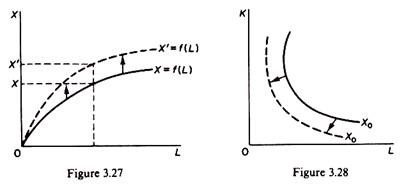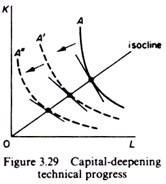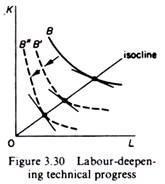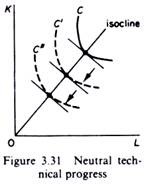As knowledge of new and more efficient methods of production become available, technology changes.
Furthermore new inventions may result in the increase of the efficiency of all methods of production. At the same time some techniques may become inefficient and drop out from the production function.
These changes in technology constitute technological progress.
Graphically the effect of innovation in processes is shown with an upward shift of the production function (figure 3.27), or a downward movement of the production isoquant (figure 3.28). This shift shows that the same output may be produced by less factor inputs, or more output may be obtained with the same inputs.

Capital-deepening technical progress:
Technical progress is capital-deepening (or capital-using) if, along a line on which the K/L ratio is constant, the MRSL K increases. This implies that technical progress increases the marginal product of capital by more than the marginal product of labour. The ratio of marginal products (which is the MRSL K) decreases in absolute value; but taking into account that the slope of the isoquant is negative, this sort of technical progress increases the MRSL K. The slope of the shifting isoquant becomes less steep along any given radius. The capital-deepening technical progress is shown in figure 3.29.
Labour-deepening technical progress:
ADVERTISEMENTS:
Technical progress is labour-deepening if, along a radius through the origin (with constant K/L ratio), the MRSL, K increases. This implies that the technical progress increases the MPL faster than the MPK. Thus the MRSL ,K, being the ratio of the marginal products [(∂X/∂L)]/[(∂X/∂K)], increases in absolute value (but decreases if the minus sign is taken into account). The downwards-shifting isoquant becomes steeper along any given radius through the origin. This is shown in figure 3.30.
Neutral-technical progress:
Technical progress is neutral if it increases the marginal product of both factors by the same percentage, so that the MRSL K (along any radius) remains constant. The isoquant shifts downwards parallel to itself. This is shown in figure 3.31.


